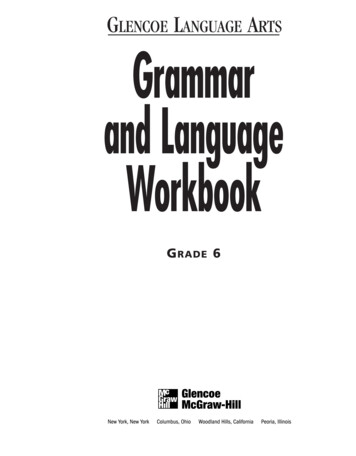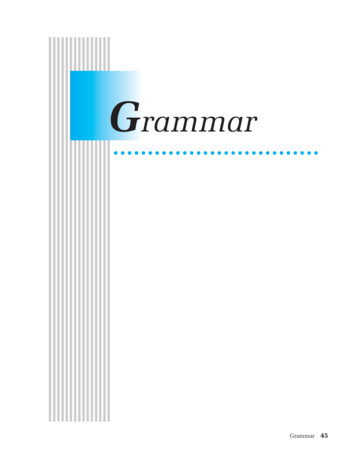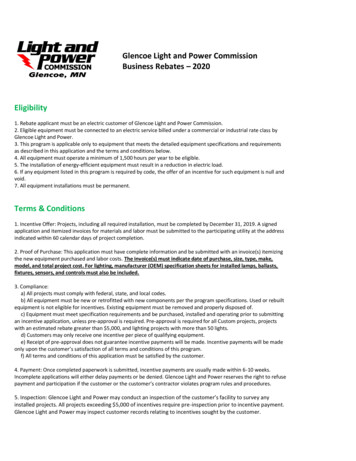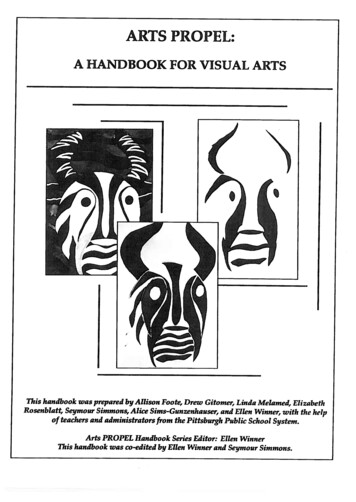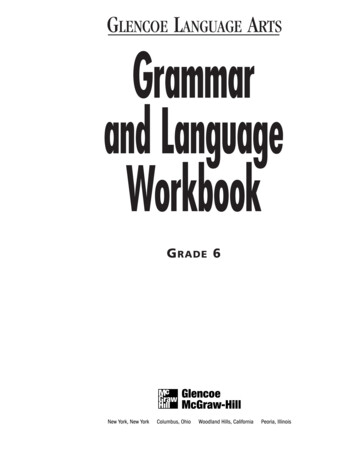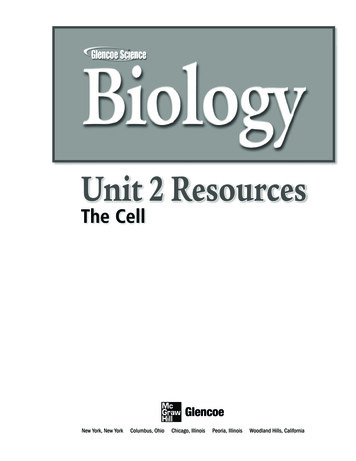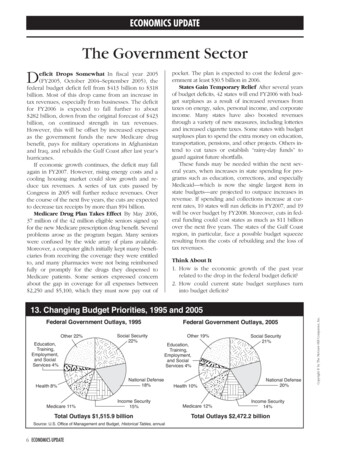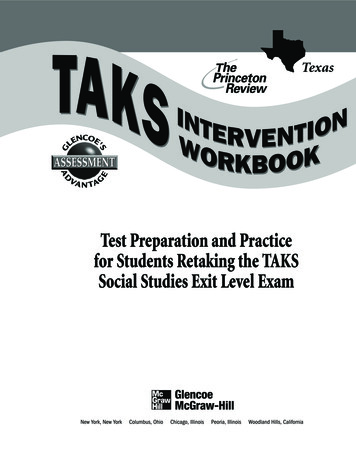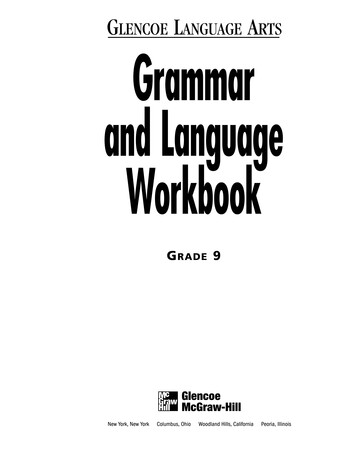
Transcription
GLENCOE LANGUAGE ARTSGrammarand LanguageWorkbookG RADE 9
Glencoe/McGraw-HillCopyright by The McGraw-Hill Companies, Inc. All rights reserved. Except as permitted under the United StatesCopyright Act of 1976, no part of this publication may be reproduced or distributed in any form or means, or stored ina database or retrieval system, without the prior written permission of the publisher.Send all inquiries to:Glencoe/McGraw-Hill936 Eastwind DriveWesterville, Ohio 43081ISBN 0-02-818294-4Printed in the United States of America1 2 3 4 5 6 7 8 9 10 024 03 02 01 00 99
ContentsHandbook of Definitions and Rules .1Troubleshooter .21Part 1 Grammar .45Unit 1 Parts of Speech1.11.2Nouns: Singular, Plural, and Collective .47Nouns: Proper and Common;Concrete and Abstract.491.3 Pronouns: Personal and Possessive;Reflexive and Intensive.511.4 Pronouns: Interrogative and Relative;Demonstrative and Indefinite.531.5 Verbs: Action (Transitive/Intransitive) .551.6 Verbs: Linking .571.7 Verb Phrases.591.8 Adjectives.611.9 Adverbs.631.10 Prepositions.691.11 Conjunctions: Coordinating, Correlative,and Subordinating; Interjections.71Unit 1 Review .73Cumulative Review: Unit 1 .74Unit 2 Parts of the Sentence2.122.13Simple Subjects and Simple Predicates.75Complete Subjects andComplete Predicates.772.14 Compound Subjects andCompound Predicates.792.15 Order of Subject and Predicate.812.16 Complements: Direct and Indirect Objects.832.17 Subject Complements and ObjectComplements.85Unit 2 Review .87Cumulative Review: Units 1–2 .88Kinds of Sentences: Interrogativeand Exclamatory.1214.31 Sentence Fragments .1234.32 Run-on Sentences.125Unit 4 Review .127Cumulative Review: Units 1– 4.128Unit 5 Diagraming Sentences5.335.34Diagraming Simple Sentences.129Diagraming Simple Sentenceswith Phrases .1315.35 Diagraming Sentences with Clauses.133Unit 5 Review .137Cumulative Review: Units 1–5.138Unit 6 Verb Tenses and Voice6.366.376.38Regular Verbs: Principal Parts.141Irregular Verbs: Principal Parts .143Tense of Verbs: Present, Past,and Future .1456.39 Perfect Tenses: Present, Past,and Future .1476.40 Tenses of Verbs .1496.41 Verbs: Progressive and Emphatic Forms.1516.42 Verbs: Compatibility of Tenses.1536.43 Voice of Verbs: Active and Passive .155Unit 6 Review .157Cumulative Review: Units 1–6 .158Unit 7 Subject-Verb AgreementPrepositional Phrases.89Participles and Participial Phrases.91Gerunds and Gerund Phrases;Appositives and Appositive Phrases.933.21 Infinitives and Infinitive Phrases .953.22 Distinguishing Participial, Gerund,and Infinitive Phrases .97Unit 3 Review .99Cumulative Review: Units 1–3.100Subject-Verb Agreement .161Subject-Verb Agreement andIntervening Prepositional Phrases.1637.46 Subject-Verb Agreementand Linking Verbs.1657.47 Subject-Verb Agreement inInverted Sentences.1677.48 Subject-Verb Agreement andSpecial Subjects .1697.49 Subject-Verb Agreement andCompound Subjects .1717.50 Subject-Verb Agreement andIntervening Expressions.1737.51 Subject-Verb Agreement and IndefinitePronouns as Subjects .175Unit 7 Review .177Cumulative Review: Units 1–7.178Unit 4 Clauses and Sentence StructureUnit 8 Using Pronouns CorrectlyUnit 3 PhrasesCopyright by 64.274.284.29Main and Subordinate Clauses.101Simple and Compound Sentences .103Complex and Compound-ComplexSentences.105Adjective Clauses.107Adverb Clauses.111Noun Clauses.115Kinds of Sentences: Declarativeand Imperative .1197.447.458.528.538.548.558.56Personal Pronouns: Case.181Pronouns with and as Appositives;After Than and As.183Who and Whom in Questions andSubordinate Clauses.185Pronoun-Antecedent Agreementin Number and Gender .187Pronoun-Antecedent Agreementin Person .189Table of Contents 1
Pronoun-Antecedent Agreement withIndefinite Pronoun Antecedents .1918.58 Clear Pronoun Reference .193Unit 8 Review .195Cumulative Review: Units 1– 8.196Unit 9 Using Modifiers Correctly9.59Modifiers: Three Degreesof Comparison .1999.60 Modifiers: Irregular Comparisons.2019.61 Modifiers: Double andIncomplete Comparisons .2039.62 Using Good or Well; Bad or Badly.2059.63 Double Negatives.2079.64 Misplaced and Dangling Modifiers .209Unit 9 Review .213Cumulative Review: Units 1–9.214Part 2 Usage .217Unit 10 Usage Glossary10.65 Usage: a to altogether.21910.66 Usage: amount to could of .22110.67 Usage: different from to regardless.22310.68 Usage: this kind to reason is because.22510.69 Usage: respectfully to where at.227Unit 10 Review .229Cumulative Review: Units 1–10 .230Part 3 Mechanics .233Unit 11 Capitalization11.70 Capitalization of Sentences .23511.71 Capitalization of Proper Nouns .23711.72 Capitalization of Proper Adjectives.239Unit 11 Review .241Cumulative Review: Units 1–11 .242Unit 12 Punctuation, Abbreviations, and Numbers12.73 End Punctuation: Period,Exclamation Point, and Question Mark .24512.74 Colons.24712.75 Semicolons .24912.76 Commas and Compound Sentences.25112.77 Commas in a Series and BetweenCoordinate Adjectives.25312.78 Commas and Nonessential Elements .25512.79 Commas and Introductory Phrases.25712.80 Commas and Adverb Clauses andAntithetical Phrases.25912.81 Commas with Titles, Addresses, andNumbers .26112.82 Commas in Direct Address, TagQuestions, and Letter Writing .26312.83 Commas in Review.26512.84 Dashes to Signal Change andto Emphasize .26712.85 Parentheses.26912.86 Quotation Marks for Direct Quotations.27112.87 Quotation Marks with Titles of ShortWorks, Unusual Expressions, and withOther Marks of Punctuation .273212.88 Italics .27512.89 The Apostrophe.27712.90 The Hyphen.27912.91 Abbreviations .28112.92 Numbers and Numerals .283Unit 12 Review .285Cumulative Review: Units 1–12 .286Part 4 Vocabulary & Spelling .289Unit 13 Vocabulary and Spelling13.93 Building Vocabulary: Learningfrom Context.29113.94 Building Vocabulary: Word Roots.29313.95 Building Vocabulary:Prefixes and Suffixes.29513.96 Basic Spelling Rules: I .29713.97 Basic Spelling Rules: II .299Review: Building Vocabulary .301Review: Basic Spelling Rules .303Part 5 Composition .305Unit 14 Composition14.98 The Writing Process: Prewriting .30714.99 The Writing Process: Drafting .31114.100 The Writing Process: Revising .31514.101 The Writing Process: Editing .31714.102 The Writing Process: Presenting .31914.103 Outlining .32114.104 Writing Effective Sentences .32314.105 Building Paragraphs .32714.106 Paragraph Ordering .33114.107 Personal Letters.33314.108 Business Letters: Letters of Request orComplaint.33714.109 Business Letters: Résumés andCover Letters .339Index .343TAE TestsUnit 1: Parts of Speech .349Unit 2: Parts of the Sentence.351Unit 3: Phrases.353Unit 4: Clauses and Sentence Structure .357Unit 5: Diagraming Sentences.359Unit 6: Verb Tenses and Voice.361Unit 7: Subject-Verb Agreement .365Unit 8: Using Pronouns Correctly.369Unit 9: Using Modifiers Correctly.371Unit 10: Usage.373Unit 11: Capitalization .375Unit 12: Punctuation, Abbreviations,and Numbers .377Unit 13: Vocabulary and Spelling.381Unit 14: Composition .383Answer Key .387Grammar and Language Workbook, Grade 9, Table of ContentsCopyright by Glencoe/McGraw-Hill8.57
Handbook ofDefinitionsand RulesHandbook 1
Nouns1.2.A singular noun is a word that names one person, place, thing, or idea: brother, classroom,piglet, and joy. A plural noun names more than one person, place, thing, or idea: brothers,classrooms, piglets, and joys.To help you determine whether a word in a sentence is a noun, try adding it to the followingsentences. Nouns will fit in at least one of these sentences:I know something about .I know something about brothers.3.I know something about a(n) .I know something about a classroom.A collective noun names a group. When the collective noun refers to the group as a whole, it issingular. When it refers to the individual group members, the collective noun is plural.The class meets two days a week. (singular)The board of trustees come from all walks of life. (plural)4.5.6.A common noun names a general class of people, places, things, or ideas: soldier, country,month, or theory. A proper noun specifies a particular person, place, thing, event, or idea.Proper nouns are always capitalized: General Schwartzkopf, America, July, or Big Bang.A concrete noun names an object that occupies space or that can be recognized by any of thesenses: tuba, music, potato, and aroma. An abstract noun names an idea, a quality, or acharacteristic: courage, sanity, power, and memory.A possessive noun shows possession, ownership, or the relationship between two nouns:Raul’s house, the cat’s fur, and the girls’ soccer ball.Pronouns1.2.A pronoun takes the place of a noun, a group of words acting as a noun, or another pronoun.A personal pronoun refers to a specific person or thing. First person personal pronouns referto the speaker, second person pronouns refer to the one spoken to, and third person pronounsrefer to the one spoken about.First Person, SingularFirst Person, PluralSecond Person, SingularSecond Person, PluralThird Person, SingularThird Person, Plural3.Objective Casemeusyouyouhim, her, itthemThey psyched themselves up for the football game.Freddie himself asked Julie out.That is a good idea! Those are my friends.An interrogative pronoun is used to form questions. A relative pronoun is used to introduce asubordinate clause. An indefinite pronoun refers to persons, places, or things in a more generalway than a noun does.Interrogative:2Possessive Casemy, mineour, oursyour, yoursyour, yourshis, her, hers, itstheir, theirsA reflexive pronoun refers to the subject of the sentence. An intensive pronoun adds emphasisto a noun or another pronoun. A demonstrative pronoun points out specific persons, places,things, or ve CaseIweyouyouhe, she, ittheyWhich is your choice?Grammar and Language Workbook, Grade 9With whom were you playing video games?Copyright by Glencoe/McGraw-HillHandbookPARTS OF SPEECH
5.The cake that we baked was delicious.Everyone has already voted.No one should enter without knocking.The antecedent of a pronoun is the word or group of words referred to by the pronoun.Ben rode his bike to school. (Ben is the antecedent of his.)Verbs1.A verb is a word that expresses action or a state of being and is necessary to make a statement.Most verbs will fit one or more of these sentences:We .We sleep.2.We loyal.We remain loyal.We it.We love it!An action verb tells what someone or something does. The two types of action verbs aretransitive and intransitive. A transitive verb is followed by a word or words that answer thequestion what? or whom? An intransitive verb is not followed by a word that answers what? orwhom?Transitive: Children trust their parents.Intransitive: The team played poorly.3.The puppy carried the bone away.The light burned brightly.A linking verb links, or joins, the subject of a sentence with an adjective, a noun, or a pronoun.The concert was loud. (adjective)I am a good card player. (noun)4.A verb phrase consists of a main verb and all its auxiliary, or helping, verbs.My stomach has been growling all morning.I am waiting for a letter.5.Verbs have four principal parts or forms: base, past, present participle, and past participle.Base:Past:6.Copyright by Glencoe/McGraw-HillIt .It snowed.I eat.I ate.Present Participle: I am eating.Past Participle:I have eaten.The principal parts are used to form six verb tenses. The tense of a verb expresses time.Simple TensesPresent Tense:She eats. (present or habitual action)Past Tense:She ate. (action completed in the past)Future Tense:She will eat. (action to be done in the future)Perfect TensesPresent Perfect Tense: She has eaten. (action done at some indefinite time or still in effect)Past Perfect Tense:She had eaten. (action completed before some other past action)Future Perfect Tense: She will have eaten. (action to be completed before some future time)7. Irregular verbs form their past and past participle without adding -ed to the base form.PRINCIPAL PARTS OF IRREGULAR VERBSBase FormbebeatbecomebeginbiteblowbreakbringPast Formwas, werebeatbecamebeganbitblewbrokebroughtPast Participlebeenbeatenbecomebegunbitten or bitblownbrokenbroughtBase FormcatchchoosecomedodrawdrinkdriveeatPast FormcaughtchosecamediddrewdrankdroveatePast nHandbook 3HandbookRelative:Indefinite:
HandbookBase layleadlendlieloseputrideringrisePast Formfellfeltfoundflewfrozegotgavewentgrewhung st Participlefallenfeltfoundflownfrozengot or gottengivengonegrownhung senBase aketeartellthinkthrowwearwinwritePast Formransaidsawsetshrank orshrunksangsatspokesprang otePast Participlerunsaidseensetshrunk ldthoughtthrownwornwonwritten8. Progressive forms of verbs, combined with a form of be, express a continuing action. Emphaticforms, combined with a form of do, add emphasis or form questions.Kari is scratching the cat.Loni has been washing the walls.We do support our hometown heroes. (present)He did want that dinner. (past)9.The voice of a verb shows whether the subject performs the action or receives the action of theverb. The active voice occurs when the subject performs the action. The passive voice occurswhen the action of the verb is performed on the subject.10.A verb can express one of three moods. The indicative mood makes a statement or asks aquestion. The imperative mood expresses a command or request. The subjunctive moodindirectly expresses a demand, recommendation, suggestion, statement of necessity, or acondition contrary to fact.I am overjoyed. (indicative)Stop the car. (imperative)If I were angry, I would not have let you in. (subjunctive)Adjectives1.An adjective modifies a noun or pronoun by giving a descriptive or specific detail. Adjectivescan usually show comparisons. (See Using Modifiers Correctly on pages 9 and 10.)cold winter2.colder wintercoldest winterMost adjectives will fit this sentence:The one looks very .The dusty one looks very old.3.Articles are the adjectives a, an, and the. Articles do not meet the above test for adjectives.4Grammar and Language Workbook, Grade 9Copyright by Glencoe/McGraw-HillThe owl swooped upon its prey. (active) The ice cream was scooped by the cashier. (passive)
A proper adjective is formed from a proper noun and begins with a capital letter.Marijka wore a Ukrainian costume.5.Handbook4.He was a Danish prince.An adjective used as an object complement follows and describes a direct object.My aunt considers me funny.Adverbs1.An adverb modifies a verb, an adjective, or another adverb. Most adverbs can showcomparisons. (See Using Modifiers Correctly on pages 9 and 10.)a. Adverbs that tell how, where, when, or to what degree modify verbs or verbals.The band stepped lively. (how)Put the piano here. (where)b.Maria writes frequently. (when)We were thoroughly entertained. (to what degree)Adverbs of degree strengthen or weaken the adjectives or other adverbs that they modify.A very happy fan cheered. (modifies adjective)2.Many adverbs fit these sentences:She thinks .She thinks quickly.She thinks fast.She thinks unusually fast.She spoke too fast. (modifies adverb)She thinks fast.She seldom thinks fast.Prepositions, Conjunctions, and Interjections1.A preposition shows the relationship of a noun or a pronoun to some other word. A compoundpreposition is made up of more than one word.The first group of students arrived.2.Copyright by Glencoe/McGraw-Hill3.They skated in spite of the cold weather.Some common prepositions include these: about, above, across, after, against, along, among,around, at, before, behind, below, beneath, beside, besides, between, beyond, but, by,concerning, down, during, except, for, from, into, like, near, of, off, on, out, outside, over, past,round, since, through, till, to, toward, under, underneath, until, up, upon, with, within, without.A conjunction is a word that joins single words or groups of words. A coordinating conjunctionjoins words or groups of words that have equal grammatical weight. Correlative conjunctionswork in pairs to join words and groups of words of equal weight. A subordinating conjunctionjoins two clauses in such a way as to make one grammatically dependent on the other.Coordinating conjunction: He and I talked for hours.Correlative conjunctions:Russ wants either a cat or a dog.Subordinating conjunction: We ate lunch when it was ready.4.A conjunctive adverb clarifies a relationship.He did not like cold weather; nevertheless, he shoveled the snow.5.An interjection is an unrelated word or phrase that expresses emotion or exclamation.Wow, that was cool!Aha! You fell right into my trap!PARTS OF THE SENTENCESubjects and Predicates1.The simple subject is the key noun or pronoun that tells what the sentence is about. Acompound subject is made up of two or more simple subjects that are joined by a conjunctionand have the same verb.My father snores.My mother and I can’t sleep.Handbook 5
The simple predicate is the verb or verb phrase that expresses the essential thought about thesubject of the sentence. A compound predicate is made up of two or more verbs or verb phrasesthat are joined by a conjunction and have the same subject.The night was cold.3.The guests sang and danced in the flower garden.The complete subject consists of the simple subject and all the words that modify it.The bright lights of the city burned intensely.4.The complete predicate consists of the simple predicate and all the words that modify it orcomplete its meaning.Dinosaurs died out 65 million years ago.5.The cheerful, soothing fire kept us warm.The sun provides heat for the earth.Usually the subject comes before the predicate in a sentence. In inverted sentences, all or part ofthe predicate precedes the subject.There are two muffins on the plate.Over the field soared the glider.Complements1.2.A complement is a word or a group of words that complete the meaning of the verb. There arefour kinds of complements: direct objects, indirect objects, object complements, and subjectcomplements.A direct object answers what? or whom? after an action verb.Sammi ate the turkey. (Sammi ate what?)Carlos watched his sister in the school play. (Carlos watched whom?)3.An indirect object receives what the direct object names.Marie wrote June a letter.4.A subject complement follows a subject and a linking verb and identifies or describes the subject.A predicate nominative is a noun or pronoun that follows a linking verb and further identifiesthe subject. A predicate adjective follows a linking verb and further describes the subject.Predicate Nominative:Predicate Adjective:5.George Washington gave his troops orders.The best football player is Jacob.The people have been very patient.An object complement describes or renames a direct object.Object Complement:Object Complement:Ami found the man handsome.Carlo thought the woman a genius.PHRASES1.2.A phrase is a group of words that acts in a sentence as a single part of speech.A prepositional phrase is a group of words that begins with a preposition and usually ends witha noun or a pronoun called the object of the preposition. A prepositional phrase can modify anoun or a pronoun, a verb, an adjective, or an adverb.One of my favorite meals is pigs in a blanket. (modifies the noun pigs)The supersonic jet soared into the sky. (modifies the verb soared)The love of a household pet can be valuable for a family. (modifies the adjective valuable)The child reads well for a six-year-old. (modifies the adverb well)3.An appositive is a noun or a pronoun that is placed next to another noun or pronoun to identifyit or give more information about it. An appositive phrase is an appositive plus its modifiers.My grandfather Géza takes me fishing.6Grammar and Language Workbook, Grade 9C.S. Lewis, my favorite author, lived in England.Copyright by Glencoe/McGraw-HillHandbook2.
A verbal is a verb form that functions in a sentence as a noun, an adjective, or an adverb. Averbal phrase is a verbal plus any complements and modifiers.a. A participle is a verbal that functions as an adjective: Gary comforted the crying baby.b. A participial phrase contains a participle plus any complements or modifiers: Thankingc.d.e.f.5.everyone, my uncle began to carve the turkey.A gerund is a verbal that ends with -ing. It is used in the same way a noun is used: Skiingis a popular sport.A gerund phrase is a gerund plus any complements or modifiers: Singing the nationalanthem is traditional at many sports events.An infinitive is a verbal that is usually preceded by the word to. It is used as a noun, anadjective, or an adverb: I never learned to dance. (noun) She has an errand torun. (adjective) I will be happy to help. (adverb)An infinitive phrase contains an infinitive plus any complements or modifiers: My fatherwoke up to watch the news on television.An absolute phrase consists of a noun or a pronoun that is modified by a participle or aparticipial phrase but has no grammatical relation to the sentence.His legs terribly tired, Honori sat down.CLAUSES AND SENTENCE STRUCTURE1.A clause is a group of words that has a subject and a predicate and is used as a sentence or partof a sentence. There are two types of clauses: main and subordinate. A main clause has a subjectand a predicate and can stand alone as a sentence. A subordinate clause has a subject and apredicate, but it cannot stand alone as a sentence.mainsub.The book bored me until I read Chapter 5.2.There are three types of subordinate clauses: adjective, adverb, and noun.a. An adjective clause is a subordinate clause that modifies a noun or a pronoun.The students who stayed after school for help did well on the test.Copyright by Glencoe/McGraw-Hillb.An adverb clause is a subordinate clause that modifies a verb, an adjective, or an adverb. Ittells when, where, how, why, to what extent, or under what conditions.When the sun set, everyone watched from the window. (modifies a verb)Today is warmer than yesterday was. (modifies an adjective)c.A noun clause is a subordinate clause used as a noun.Who will become president has been declared.3.I now remember what I need to buy.Main and subordinate clauses can form four types of sentences. A simple sentence has only onemain clause and no subordinate clauses. A compound sentence has two or more main clauses.A complex sentence has one main clause and one or more subordinate clauses. A compoundcomplex sentence has more than one main clause and at least one subordinate clause.mainSimple:The stars fill the sky.mainmainCompound:The plane landed, and the passengers left.sub.mainComplex:Although the children found the letter, they couldn’t read it.mainmainsub.Compound-Complex: The earth is bountiful; we may destroy it if we abuse it.Handbook 7Handbook4.
A sentence that makes a statement is classified as a declarative sentence: The ClevelandBrowns are my favorite team. An imperative sentence gives a command or makes a request:Please go to the dance with me. An interrogative sentence asks a question: Who wouldabandon a family pet? An exclamatory sentence expresses strong emotion: Look out!SUBJECT-VERB AGREEMENT1.A verb must agree with its subject in person and number.Doli runs. (singular)Doli and Abay run. (plural)He is singing. (singular) They are singing. (plural)2.In inverted sentences the subject follows the verb. The sentence may begin with aprepositional phrase, the words there or here, or the verb form of do.Out of the bushes sprang the leopard.Do those pigs eat leftover food?3.There is never enough time.Do not mistake a word in a prepositional phrase for the subject.The boss of the employees works very hard. (The verb works tells the action of the boss.)4.Make the verb in a sentence agree with the subject, not with the predicate nominative.Her problem was the twins.5.The twins were her problem.A title is always singular, even if nouns in the title are plural.The War of the Worlds was a radio broadcast that caused widespread panic.6.Subjects combined with and or both use plural verbs unless the parts are of a whole unit.When compound subjects are joined with or or nor, the verb agrees with the subject listed last.Chocolate, strawberry, and vanilla are common ice cream flavors.Peanut butter and jelly is a good snack.Neither books nor a briefcase is needed.7.Use a singular verb if the compound subject is preceded by the words many a, every, or each.Every dog and cat needs to be cared for.8.Many a young man has stood here.A subject remains singular or plural regardless of any intervening expressions.Gloria, as well as the rest of her family, w
Jul 04, 1984 · 8.57 Pronoun-Antecedent Agreement with Indefinite Pronoun Ante
